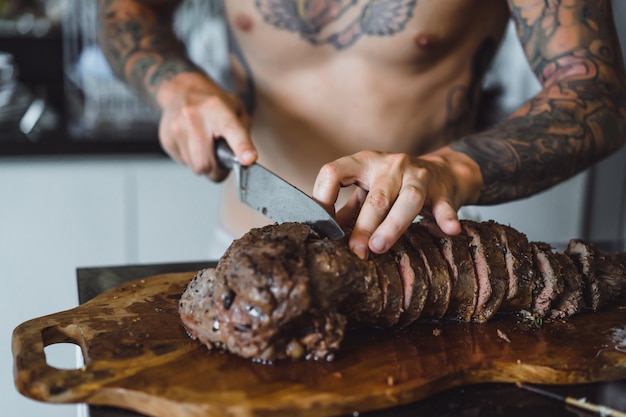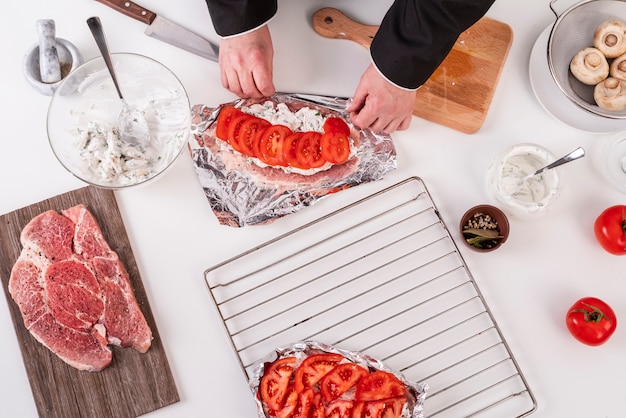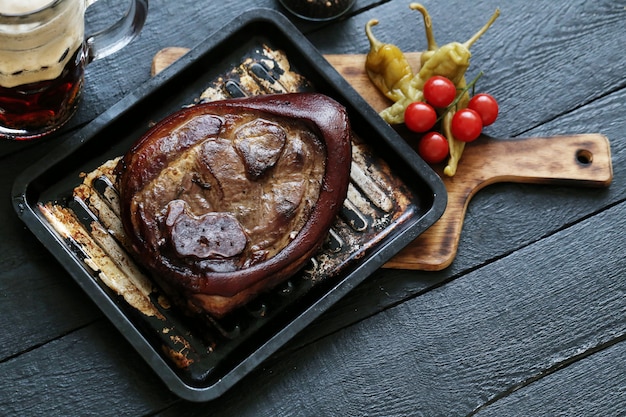(Part 1) choosing the right cut: The Foundation of Flavor

The Cut Makes All the Difference: A Deep Dive
Think of a steak as a canvas, and the cut is your paintbrush. Choosing the right cut is crucial for achieving that perfect steak experience. Why? Because different cuts of beef have different levels of marbling, which translates to variations in tenderness, flavour, and overall texture.steak cuts for Every Occasion: A culinary journey
- Rib-Eye: This cut is the undisputed king of the steak world. Rib-eye is known for its luxurious marbling, meaning it has a high concentration of fat interwoven within the muscle. This translates into a rich, buttery flavour and an unbelievably tender texture. It's ideal for grilling or pan-frying and is perfect for special occasions or when you're looking to indulge in a truly decadent steak experience. It's my personal favourite, and for good reason.
- new york strip: This cut comes from the short loin and is a bit leaner than rib-eye, but still boasts a good amount of marbling. It offers a more pronounced beefy flavor and a slightly firmer texture than rib-eye, making it another excellent choice for grilling or pan-frying. It's a fantastic option when you're looking for a steak with a bit more bite and a robust flavour profile.
- Sirloin: Sirloin is a more budget-friendly option, known for its leaner profile and firm texture. It's a versatile cut that works well for grilling, pan-frying, or even baking in the oven. Just remember that since it's leaner, you'll need to be extra careful not to overcook it. I often use sirloin for quick and easy weeknight meals.
- filet mignon: The most tender cut of beef, filet mignon is a smaller cut from the tenderloin. It's also the most expensive, making it perfect for special occasions or when you want to treat yourself to the ultimate steak experience. Filet mignon is best cooked to rare or medium-rare, as it can dry out quickly if cooked any further. It's a delicate cut that melts in your mouth.
- flank steak: Flank steak is a more budget-friendly option, known for its long, thin shape and slightly tougher texture. But don't be fooled by its toughness; flank steak is packed with flavor and perfect for marinating. It's great for stir-fries, fajitas, and other dishes where you want to slice it thinly against the grain. When cooked correctly, it becomes tender and flavorful, proving that even tougher cuts can shine.
(Part 2) The Importance of Temperature: The Key to Doneness

Why Temperature Matters: The Science of Cooking
We've all been there. You've got a beautiful piece of steak, all ready to go, and you're eager to get it on the grill. Then, the doubts creep in: "Is it cooked enough? How do I know?" This is where a trusty meat thermometer becomes your culinary best friend. It's the ultimate tool for ensuring your steak is cooked to your exact liking, every time.The Temperature Chart: Doneness Decoded
| Doneness | internal temperature (°F) | Internal Temperature (°C) |
|---|---|---|
| Rare | 125-130 | 52-54 |
| Medium-Rare | 130-135 | 54-57 |
| Medium | 140-145 | 60-63 |
| Medium-Well | 150-155 | 65-68 |
| Well Done | 160 | 71 |
My Take on Doneness: A Personal Preference
I'm a firm believer in medium-rare. That beautiful pink center, the juicy flavor – it's a symphony of textures and tastes. But remember, doneness is a highly personal preference. Don't be afraid to explore different levels of doneness and find what suits your palate. The key is to understand the temperature ranges and use your meat thermometer to guide you.(Part 3) Mastering the Grill: The Art of Outdoor Cooking

The Art of Grilling: A Culinary Tradition
Grilling is more than just a method of cooking; it's a culinary tradition that brings people together. It's a celebration of smoky flavors and char marks, adding a unique depth to your steak. It's also a fantastic way to enjoy the outdoors, especially during the warmer months.Getting Your Grill Ready: The Foundation of Success
- Clean and Preheat: Always start with a clean grill. Use a grill brush to remove any debris and food particles. Then, preheat your grill to medium-high heat. For gas grills, this usually takes about 10-15 minutes. For charcoal grills, wait until the coals are glowing red and covered in a layer of white ash.
- Direct or Indirect: For steak, you'll want to use direct heat. This means placing your steak directly over the heat source, ensuring a consistent and even sear. This method is ideal for achieving those beautiful grill marks and locking in the juices.
Grilling Your Steak: Step by Step
- Seasoning: Salt and pepper are the cornerstone of any good steak. Season generously, making sure to cover all sides. Feel free to add other spices like garlic powder, onion powder, paprika, or even a pinch of chili powder to enhance the flavor profile.
- Sealing: Place your steak on the preheated grill. Resist the urge to move it for at least 2 minutes. This initial phase allows for a proper sear on the bottom, which helps lock in the juices and creates a delicious crust.
- Flip and Cook: After 2 minutes, flip the steak over and cook for another 2 minutes on the other side. Continue flipping and cooking, adjusting the heat as needed, until your steak reaches the desired level of doneness. Remember, you can always use your meat thermometer to check the internal temperature.
- Rest: Once your steak is cooked, remove it from the grill and let it rest for 5-10 minutes before slicing and serving. This crucial step allows the juices to redistribute throughout the steak, ensuring a tender and juicy final product.
(Part 4) Pan-Frying Perfection: The Art of Indoor Cooking
The Pan-Frying Method: A Versatile Technique
For those who don't have a grill or prefer the convenience of indoor cooking, pan-frying is an excellent alternative. You can achieve that beautiful crust and perfectly cooked interior right in your own kitchen.Essential Equipment: Tools of the Trade
- cast iron skillet: This is the ultimate pan for pan-frying steak. Cast iron is known for its exceptional heat retention, providing a consistently hot surface for a perfect sear. It also develops a natural patina over time that adds flavor to your food. If you don't own a cast iron skillet, I highly recommend investing in one. They're incredibly versatile and will last a lifetime with proper care.
- Heavy-bottomed Skillet: If you don't have a cast iron skillet, a heavy-bottomed skillet will do the trick. Look for one made from stainless steel or copper. These materials are also excellent heat conductors and will provide a similar result. Just make sure the skillet is thick enough to distribute heat evenly.
Pan-Frying Your Steak: Step by Step
- Heat the Pan: Heat your skillet over medium-high heat for about 5 minutes. You want the pan to be hot enough to sear the steak without burning it. A good way to test the heat is to splash a drop of water onto the pan. If it sizzles and evaporates quickly, your pan is ready.
- Add Oil: Add a generous amount of oil to the hot pan. I prefer to use a high-heat oil like canola or grapeseed oil. Olive oil has a low smoke point and tends to burn at high temperatures, which can affect the flavor of your steak.
- Sear the Steak: Carefully place your steak in the hot pan. Don't move it for at least 2 minutes. This initial phase allows for a beautiful sear on the bottom, similar to grilling, creating that crispy crust. You'll hear a gentle sizzle as the steak makes contact with the hot oil.
- Flip and Cook: After 2 minutes, flip the steak over and cook for another 2 minutes. Continue flipping and cooking, adjusting the heat as needed, until your steak reaches the desired level of doneness. Remember to use your meat thermometer to confirm the internal temperature.
- Rest: Once your steak is cooked, remove it from the pan and let it rest for 5-10 minutes before slicing and serving. This allows the juices to redistribute throughout the steak, resulting in a juicier, more tender final product.
(Part 5) The oven method: A Simple Approach for Busy Cooks
Oven-Cooking for a Stress-Free Steak: Convenience at Its Finest
Sometimes, you just want a simple, fuss-free way to cook a steak. The oven is a great option, especially if you're cooking for a large group or if you just want to relax and let the oven do the work. It's also a great choice for those who prefer a more even cooking method.Getting Ready: Setting the Stage
- Preheat the Oven: Preheat your oven to 400°F (200°C). This will ensure that the steak cooks evenly and quickly, preventing any cold spots that can lead to uneven doneness.
- Season the Steak: Season your steak generously with salt and pepper, and feel free to experiment with other spices like garlic powder, onion powder, paprika, or chili powder. The key is to cover the steak thoroughly, allowing the seasonings to permeate the meat.
- Grease the Baking Sheet: Grease a baking sheet with a little oil. This will prevent the steak from sticking to the baking sheet and ensure a clean release.
Baking Your Steak: Step by Step
- Bake: Place the baking sheet in the preheated oven and bake for 10-15 minutes for a medium-rare steak. Adjust the baking time based on your desired level of doneness. I always recommend using a meat thermometer to confirm the internal temperature. It's a crucial step in ensuring a perfect result.
- Rest: Once the steak is cooked to your liking, remove it from the oven and let it rest for 5-10 minutes before slicing and serving. This allows the juices to redistribute throughout the steak, creating a more tender and juicy final product.
(Part 6) Beyond the Basics: Adding Flavor with Marinades
Marination Magic: A Flavor Transformation
Sometimes, you want to take your steak game to the next level. That's where marinades come in. Marinades are a powerful tool for adding flavor and tenderness to your steak. Think of them as a flavor bath that infuses your steak with a symphony of tastes.My Favorite Marination Tips: A Taste of Inspiration
- Acidic Ingredients: Citrus juices (lemon, lime, orange) and vinegar are fantastic for tenderizing and adding brightness to your marinade. The acidity helps to break down the tough proteins in the meat, resulting in a more tender texture. I always include a good amount of citrus juice or vinegar in my marinades.
- Oils: Olive oil, grapeseed oil, or even sesame oil are essential for locking in moisture and adding richness to your marinade. The oil creates a protective barrier around the steak, preventing it from drying out during the marination process. It also helps to enhance the flavor and create a more tender texture.
- Herbs and Spices: Get creative with herbs and spices! Fresh or dried herbs like rosemary, thyme, basil, or oregano add a touch of herbal freshness. Spices like garlic powder, onion powder, paprika, or chili powder add depth and complexity to your marinade. I always keep a variety of herbs and spices on hand, allowing me to experiment with different flavor combinations.
- Soy Sauce: Soy sauce adds a unique umami flavor and depth to your marinade. It also helps to tenderize the meat. Soy sauce is a versatile ingredient that complements many different flavor profiles, making it a valuable addition to marinades.
- Honey or Maple Syrup: A touch of sweetness, like honey or maple syrup, can balance out the acidity and add a beautiful caramelized flavor to your steak. It creates a rich and complex flavor profile that elevates the steak to new heights.
(Part 7) Mastering the Rest: The Importance of PatienceWhy Resting is Crucial: Unlocking Flavor and Tenderness
It's tempting to dive right into that juicy steak after cooking, but a little patience goes a long way. Resting your steak is a crucial step in unlocking its full potential. It allows the juices to redistribute throughout the steak, resulting in a more tender and flavorful final product. Resting Time: Awaiting Perfection
The general rule of thumb is to let your steak rest for 5-10 minutes. For larger steaks, you may need to rest for a bit longer. You'll know it's ready when the juices stop running out of the steak. (Part 8) Serving Up steak perfection: A Culinary Masterpiece
The Perfect Sides: Complementing the Star of the Show
- Classic mashed potatoes: Creamy and comforting, mashed potatoes are a classic pairing for any steak. The smooth texture and buttery flavor create a perfect contrast to the rich, savory steak. It's a timeless combination that's always a crowd-pleaser.
- Roasted Vegetables: Roasted vegetables like asparagus, broccoli, or Brussels sprouts add a burst of freshness and color to your plate. The roasting process intensifies their natural flavors, creating a delicious complement to the steak. You can even roast root vegetables like carrots, potatoes, and parsnips for a heartier and more complex side dish.
- Green Salad: A simple green salad with a light dressing is a refreshing counterpoint to a rich steak. It helps to cleanse the palate and adds a touch of lightness to your meal. Choose leafy greens like spinach, romaine, or arugula, and top it with a simple vinaigrette for a flavorful and satisfying side.
- Mac and Cheese: Okay, this one might not be the healthiest option, but it's undeniably delicious. Creamy, cheesy, and comforting, mac and cheese is a classic pairing for steak. It's the perfect indulgence for those who want to enjoy a truly decadent meal.
Slicing and Serving: The Final Touch
- Slice Against the Grain: When slicing your steak, be sure to cut against the grain of the muscle fibers. This will make the steak easier to chew and more tender. The grain runs in the direction the muscle fibers are arranged, and cutting against it breaks down the fibers, resulting in a more tender bite.
- Plate with Care: Arrange your steak beautifully on a plate, and add your sides. You can also garnish with fresh herbs, a lemon wedge, or a sprig of rosemary for a touch of elegance. Presentation is important, as it enhances the overall dining experience. Take pride in creating a visually appealing and delicious masterpiece.
FAQs
1. How do I know if my steak is done?
The best way to determine if your steak is cooked to your liking is to use a meat thermometer. It's the most accurate way to gauge the internal temperature, ensuring a consistent result. Refer to the temperature chart for the desired level of doneness.
2. What if I overcook my steak?
Don't panic! While overcooked steak won't be as juicy as a perfectly cooked one, it's still edible. Try slicing it thinly and topping it with a flavorful sauce to add moisture and enhance the flavor. A rich sauce like a mushroom sauce or a creamy garlic butter sauce can help to mask the dryness and make the steak more enjoyable.
3. Can I cook steak in a slow cooker?
It's not recommended to cook steak in a slow cooker. The long cooking time can make the steak tough and dry. Slow cookers are better suited for tougher cuts of meat that benefit from a longer cooking time, like chuck roast or brisket. For steak, you want a quick and high-heat cooking method to preserve tenderness and juiciness.
4. What are some good steak sauces?
There are countless delicious steak sauces out there, and the best choice depends on your personal preference. Here are a few classic options that are sure to please:
- Béarnaise sauce: A rich and creamy emulsion of egg yolks, butter, and tarragon. It's a classic French sauce that adds a luxurious touch to any steak.
- Peppercorn sauce: A flavorful sauce made with cracked peppercorns, butter, and often brandy or other liquor. It adds a bold and peppery kick to the steak.
- Garlic butter sauce: A simple and flavorful sauce made with melted butter, garlic, and often parsley or lemon juice. It's a classic and crowd-pleasing option that adds a touch of garlic flavor to the steak.
- Mushroom sauce: A rich and savory sauce made with sauteed mushrooms, broth, and often cream or wine. It adds a deep umami flavor to the steak.
5. How long can I marinate a steak?
You can marinate a steak for as little as 30 minutes, but for best results, marinate it for at least 2 hours, and up to 24 hours. A longer marination time allows the flavors to penetrate the meat more thoroughly, creating a more flavorful and tender result. Just make sure to store the steak in the refrigerator during the marination process.
Enjoy your steak journey!Everyone is watching

How to Cook Frozen Lobster Tails Perfectly: A Step-by-Step Guide
RecipesLobster. Just the word conjures up images of lavish meals, special occasions, and a taste of luxury. But let's...

Pigs in a Blanket Cooking Time: How Long to Bake for Perfect Results
RecipesAh, pigs in a blanket. Just the name conjures up images of those delightful little parcels of crispy pastry en...

Pork Fillet Cooking Time: How Long to Cook It Perfectly
RecipesPork fillet, or tenderloin as it's sometimes called, is a real favourite in our house. It's so versatile, and...

The Ultimate Guide to Tender, Juicy Pulled Pork
RecipesRight, let's talk pulled pork. It's one of those dishes that just screams "comfort food," doesn't it? I mean...

The Ultimate Guide to Cooking Delicious Frankfurters
RecipesLet's face it, we all love a good frankfurter. It's a classic, simple, and always satisfying. But let's be rea...
